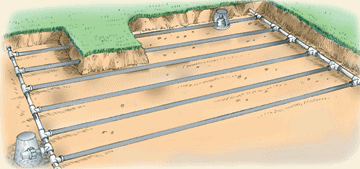This week part of the Staghorn team, Colin and I, had the thrilling experience of attending a course at the New York Botanical Gardens about irrigation systems. Irrigation systems are a great idea if you have a landscaped property and you want to keep it looking nice while also conserving water. This is a little guide to some of your options for irrigation.

Underground Sprinkler Systems
This system is best installed before landscaping is done. Parts of the landscape will need to be dug up and replanted if not. Your plants will need to be organized into hydrozones; plants with similar water needs should be grouped together. Each zone will be on it’s own timer and have different sprayer heads that fit to that hydrozone’s needs.
 |
| An example of different hydrozone areas |
Pros
- Good for large spaces and lawns
- Very far spray range
- Pop up sprayer heads are available so they can be out of sight when not in use
Cons
- High water usage
- Sprayer heads are easily broken by foot traffic, vandalism or mowers
- Water loss from overspray and evapotranspiration
- Can only be on certain hours or plants can become scorched
- Needs higher water pressure
Drip Irrigation
This system involves laying tubing throughout or under the planting area. The tubing has drip holes which allows water to slowly seep out into the ground around the plants. If the tubing is underground, trenches are dug and the piping is laid in a grid, covered and then planted. If it is above ground, the piping can be laid around the planted area and then covered with mulch.
 |
| Drip layout under sod |
Pros
- Can be fit into any shape or size area
- Can be installed underground or above
- Can be added to old sprinkler systems
- There are adapters available to turn sprayer heads into dripline connectors
- Great for water conservation
- Uses far less water than sprinkler systems
- Easy to find and fix damaged tubing
- Works with low water pressure
- Water goes directly where you need it
- It is not wasted through evaporation, wind, or surface run off
Cons
- It may be hard to see that the ground is getting wet
- Since the piping is underground or under mulch, the surface may look dry even though it’s damp below
 |
| Microdrip lines off of larger tubing |
MicroDrip Irrigation
Microdrip is great for small gardens, rooftops, balconies, container gardens, or being very specific for a certain plant’s watering needs. It uses smaller tubing than normal drip irrigation. This allows you to plug into the larger drip tubes anywhere along the tube and feed water directly where you want it to go. Emitters are added to the ends which allow you to choose specific water flow to each plant.


No comments:
Post a Comment